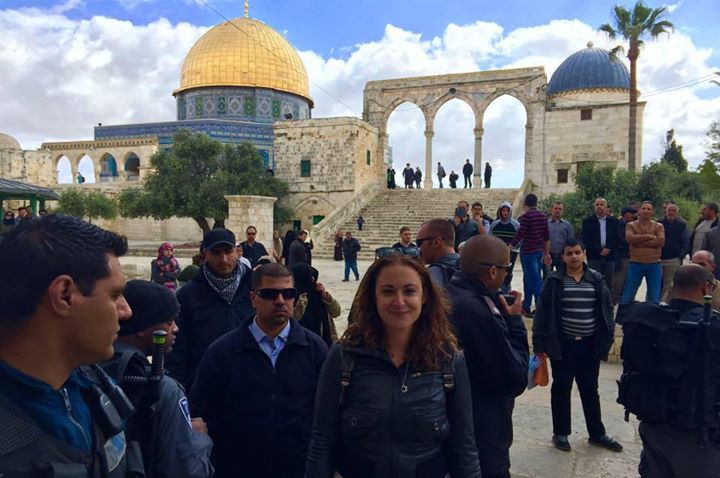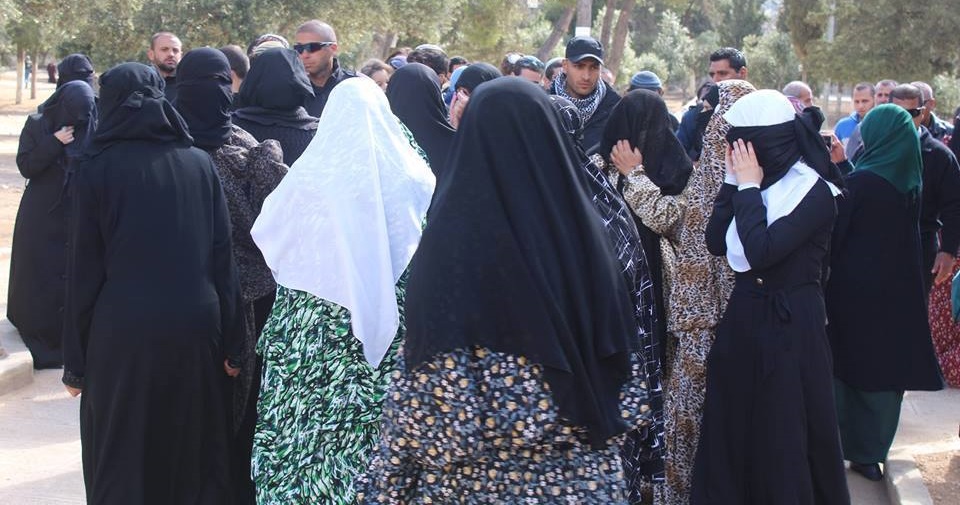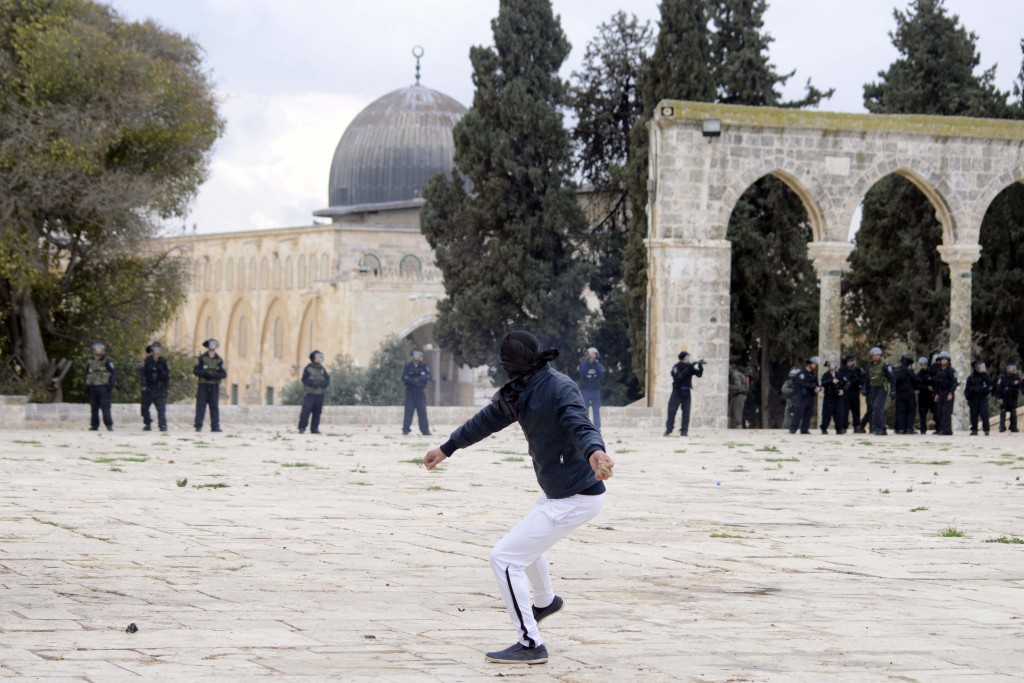For a thousand years it stood as the pinnacle of sanctity in Judaism, and for two thousand more as the focus of our dreams. So why can’t a Jew even mumble a prayer there?
They’ve been in that back room for a while. I’m standing by the door, trying to ascertain what’s going on by the mumblings and the gestures. I feel like a child, trying to coax my superior with an insecure smile. The policeman comes back, eyeing me up and down, holding my passport in his right hand. You’re a journalist, he says. You’re not allowed to enter.
I have already been there for almost two hours, waiting to be allowed to ascend, but the line allocated for Jews isn’t moving. The other one is, though. The tourist line is moving bodies as were it the entrance to an amusement park. I had stood in that line, swooshing past security, just a few months earlier.
Something shifted in me this past October, after learning about the assassination attempt on Rabbi Yehuda Glick, an activist who campaigns for greater Jewish access to the Temple Mount. The Mount had represented an ache in my heart, but stayed there, as elusive as a dream. Every time I visited The Western Wall, I would feel sadness and loss, knowing that I was so close, yet so far away, but somehow I had accepted the status quo and settled for this state of silent complacency. Then someone drove up on a motorcycle and tried cutting down a man who had kept the dream alive for all of us, and I knew in my heart that this could not stand.
The 37 acres of the Temple Mount constitute the most contested piece of religious property in the world. This is a place that has been holy to us Jews for thousands of years—even before creation, according to the Midrash—and it is here we find the Foundation Stone, at the heart of the Dome of the Rock, from where the whole world was created and where the rebuilding of our third Temple one day will take place. It is also the third-holiest site in Islam, where Muslims believe Muhammad’s ascension to heaven took place after his night-journey to Jerusalem. The al-Aqsa Mosque and the Dome of the Rock were constructed on the Temple Mount in 637 CE, after the Muslim conquest of Jerusalem. The mosque faces Mecca on the far-south side of the Mount, with the Dome of the Rock standing on the site of the Holy Temple, directly over the Holiest of Holies.

The author on the Temple Mount, surrounded by police officers for her own protection. Photo: Annika Hernroth-Rothstein
In 1967, at the end of the Six-Day War, the whole city of Jerusalem was reunited under Israeli sovereignty. Israeli authorities faced the question of what to do about the Temple Mount, then under religious management of the Jordanian clerical authority known as the Waqf. According to Jewish religious law dating back to the original Temple of King Solomon, Jews are prohibited from visiting the most sacred parts of the Temple Mount, but a large portion of the area consists of later extensions that were erected under Roman rule and that hold no such limitations. The Israeli government, however, decided to put a broad-stroke policy in place, giving de facto control of the Temple Mount to the Waqf. The Chief Rabbinate echoed this decision by putting up a sign at the entrance, saying that Jews are forbidden to ascend and pray on any portion of the Temple Mount. This policy, driven through by then-Minister of Defense Moshe Dayan, has resulted not only in systematic destruction of the site by Muslim authorities trying to wash away proof of Jewish presence and history on the Temple Mount, but also in Jewish worshippers entering the area without proper rabbinic guidance, at risk of unknowingly violating religious law.
The Temple Mount is described as being under a “status quo,” but the reality is something entirely different. In the decades since the end of the Six-Day War, the Waqf and the Muslim authorities have desecrated the Jewish holy site by destroying archeological treasures, using the Israeli government’s fear of disrupting the relative peace to engage in illegal construction. Take, for example, Masjid Al-Marwani, a large underground mosque built in the area known as Solomon’s Stables. The mosque, built in 1996 without permission from the Israeli government and without any archeological supervision, holds approximately 10,000 worshippers.
I’m standing on the Kotel Plaza at 7:00 AM, and although I am trying to take in the magic of the light and the familiar bustle before shacharit prayers, my heart is racing a mile a minute. I’ve prepared for weeks, yet I feel unprepared, stepping into a foreign realm that ought to be known.
“You look too religious.”
My guide gestures to my head-wrap and foot-length skirt.
“If you’re not married, uncover your hair. We don’t want any unnecessary trouble.”
It takes me less than a minute to get from the plaza to the Temple Mount, and while my guide has a brief conversation with the Waqf authorities in Arabic, I just stand there, taking it all in. I was there, there, at the place I had painted pictures of in my mind. I’m not sure what I had expected, but I know that it was not what I saw.
I’m there for three hours, walking alongside my guide in quiet conversation, stopping to take pictures at each and every turn. In the corner of my eye I see them, the religious Jews, moving ever so slowly across the walkway, surrounded by the Waqf, Israeli police, and women covered in heavy black cloth. I hear screams, and I’m not sure which feeling in me is more prevalent—the relief of not being under attack or the shame over the very same. We leave quietly, exciting through the Arab Quarter, and as happy as I am to have come I know I hadn’t really been there. The decision was made before I knew it—I had to come back and be counted.
Over the past year, Jordan and the Palestinian Authority have been regularly condemning visits by Jews to the Temple Mount and spreading rumors that the Israeli government plans to storm the Mount and destroy the Muslim holy sites. Some Palestinian groups have been paying women to harass Jewish visitors, the funding for these groups being largely cloaked in mystery. The false rumors of an Israeli coup are, quite ironically, able to persist due to the inaction of the Israeli government on the issue of harassment of and violence toward Jews on the Mount. The government’s unwillingness to intervene increases the appetite of the Muslim side, which notices that their acts of terror go without punishment—and to a large extent, even without notice from the broader public. Initially, Muslim prayer was limited to the al-Aqsa Mosque, but as Jordan and the Waqf have gained more power over the area, Muslim prayer has spread to take place throughout the entire area. And as the Muslim presence has increased, the Israeli police have often chosen to close the Temple Mount to Jews entirely, rather than risk violence and rioting. Prime Minister Benjamin Netanyahu has publicly declared that there will be no changes in the status quo, a promise he has repeated to King Abdullah of Jordan and Federica Mogherini, the European Union’s foreign policy chief, who visited Israel after escalations in violence on the Temple Mount.
It is Yom Ha’atzmaut, Israeli Independence Day.
Once I get through the initial checkpoint, I am left standing with nine other Jews in the secondary waiting area. A policeman tells us what the rules are: No singing, no praying, and no moving of lips in a prayer-like manner. He turns to me and says that I am not allowed to ask any questions while I am up there, I am entering as a private person, not a journalist. Finally, he tells me to remove my Israeli flag pin that I always wear on my lapel, and as I hand it to him he nods, and goes on his way.
The waiting area has no roof, no seating, no water, and no shade. A man in our group initiates an ad-hoc d’var Torah and I am thankful to him for picking me up just as I feel myself losing spirit. As he is speaking, I see the tourists pass again, some of them looking at me apologetically. I gave that same look, just a few weeks ago, and suddenly I feel my resolve returning, knowing that I am exactly where I am supposed to be.
As we enter, we are immediately surrounded. The chanting is deafening.
With our blood and souls we will defend al-Aqsa!
With our blood and souls we will defend al-Aqsa!
With our blood and souls we will defend al-Aqsa!
Initially there are ten women, pointing, getting in our faces, voices loud and shrill.
Allahu Akbar! Allahu Akbar!
The four Israeli policemen guarding us make a half-hearted attempt of putting some distance between them and our group, putting their hands up, telling them to move back.

The author and other Jewish visitors to the Temple Mount, surrounded by people shouting and threatening them. Photo: Annika Hernroth-Rothstein
And then it happens. The women in black accuse the police of touching them, shrieking and crying at the top of their lungs, and suddenly 40 men come from nowhere, surrounding us on each side. I feel the panic creeping in, and as I watch the faces of the policemen, I see I am not alone in my fear. This situation is unraveling, and we all know that at this point, anything can happen. We are told by the police not to speak to each other at all, but to walk in silence the rest of the way. We comply, but the mob just keeps building, both in numbers and intensity, forcing our little group to move forward at a glacial pace.
They are filming us, non-stop, cameras in my face, the women poking my arm, forcing me to meet their gaze. It feels like a warzone. It is Israeli sovereign land, but I feel like I have crossed over into enemy territory and ventured out alone. I look over at my fellow Jews, strangers when this all began, and they smile at me as to say that we will be fine, just do what they say and keep on walking. Once we reach the gates again I ask the police if I can stop for a minute, but they usher us out, and I exit with a mix of exhilaration and emptiness that I had never known before this day.
When I got back to my apartment in Abu Tur I broke down and cried. What got to me more than anything was standing in a separate line for Jews, waiting for hours, on the day of our independence. I am in Israel, in our capitol, and yet we have separate lines for Jews and non-Jews as if no lesson has been learned from our past. Is this the independence and the strength that we celebrate? Is it freedom when I cannot pray or even move my lips without being blacklisted or thrown out from this, our holiest site?
I am not a woman who scares easily, nor do I tend to cry, but I had never seen hatred like I saw that day. I was shaken. I was angry. I was humiliated and ashamed at my own inaction.
The Universal Declaration of Human Rights proclaims that freedom of movement and freedom of prayer are basic rights, yet none of this applies to Jews on the Temple Mount. We were treated as less than human that day, as we are being denied our basic rights every day.
Operatives of Hamas, the Islamic Movement in Israel, and Mahmoud Abbas’ Fatah party are responsible for instigating the recent events on the Temple Mount. Hamas has transferred money to activists of the Islamic Movement as payment for their presence on the Mount, to create disturbances there, and prevent access to Jews. The al-Aqsa Mosque has served as a base for repeated attacks on visitors and on policemen who have tried to protect them. From within the mosque, stones and Molotov cocktails have been thrown directly at policemen and visitors. The mosque itself has become a barricaded storeroom for projectiles and a refuge for rioters.
In October 2014, Abbas held a widely broadcasted speech, where he proclaimed that “Settlers must be prevented from entering the Temple Mount—by any means. It is forbidden to let Jews go up to the Temple Mount. We must prevent this in any way possible. The Temple Mount is ours, the al-Aqsa Mosque is ours, and the churches are ours. They do not deserve to enter these places and defile them.” This incitement resulted in violent riots on the Mount. Two weeks later, there was an assassination attempt on Rabbi Yehudah Glick as he was exiting a lecture in Jerusalem.
We may speak of the “status quo,” but if one looks closer at the issue one understands that there is no such thing as a status quo on the Temple Mount. The Muslim presence is ever-growing while the Jewish presence is deterred through violence and intimidation. The one rule that seems to be upheld is the prohibition for Jews to pray there, whereas their right for Jews to visit according to the relevant laws is being violated on a daily basis.

A Muslim boy throws stones at Israeli police during clashes following Friday prayers at Jerusalem’s al-Aqsa mosque, December 6, 2013. Photo: Sliman Khader / Flash90
What Dayan saw as a non-issue while striking the deal on the Mount in 1967 has now become a focal point for the entire conflict and a symbol of Muslim strife in the Middle East. This is not an issue, but the issue. The decision represents not only a historical mistake, but also a possible future calamity. What my visits to the Temple Mount taught me was that this is not merely a religious issue or even an issue of national security. This is at its core a question of basic human rights—a term hijacked by some and too often forgotten by the rest of us. We cannot accept being the “other” here, in our land, in our capital. We cannot cower or look away for the sake of appeasement—this cannot stand and it must not be avoided.
They say that the best lack all conviction, while the worst are full of passionate intensity. What I felt before I went up on the Temple Mount, the fear that dwelled in me, was the dream being silenced by the criers on the mountain. And it was, both times, in radically different yet oddly similar ways. First I was made to hide who I am, and then I was terrorized, because of it. I walked in silence, tears burning the back of my throat, my back hunched in humiliation. That is terror, at its core, to make fear so prevalent that we end up thinking that we chose to stay away. To take the dream, inch-by-inch, until we no longer remember what it stood for.
![]()
Banner Photo: Sliman Khader / Flash90





